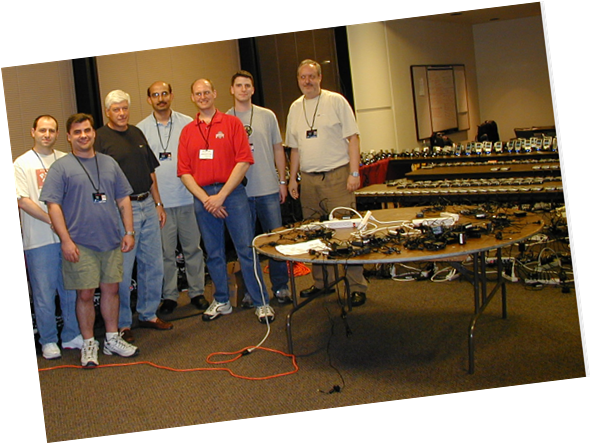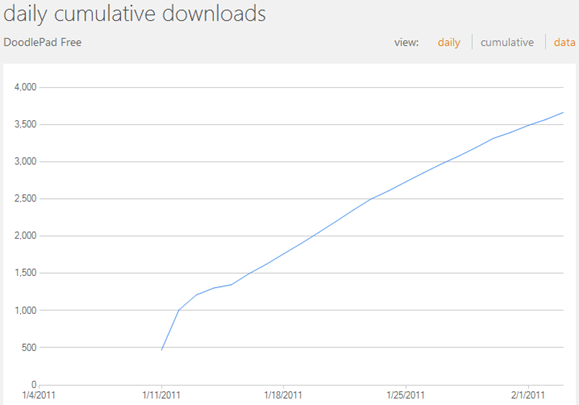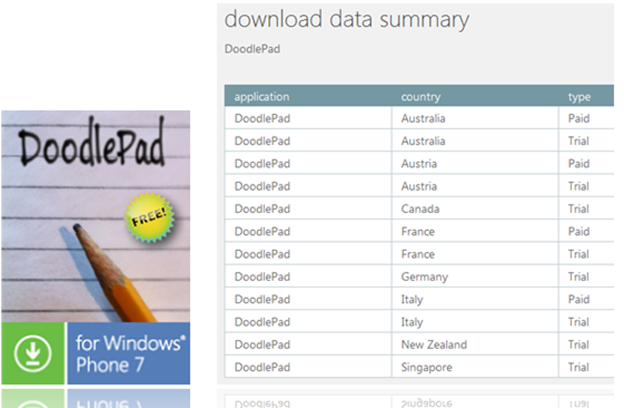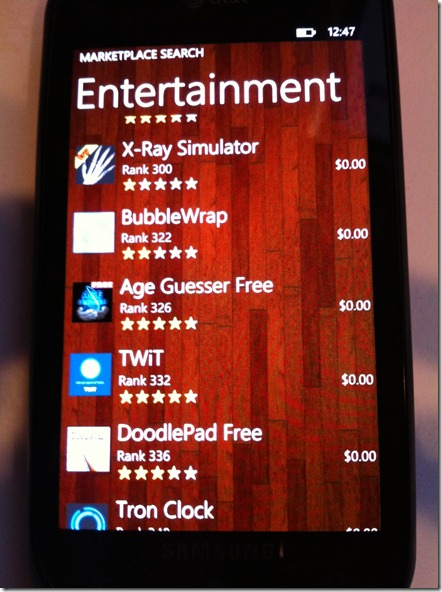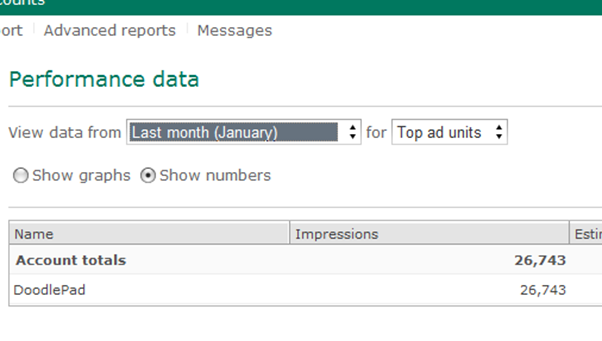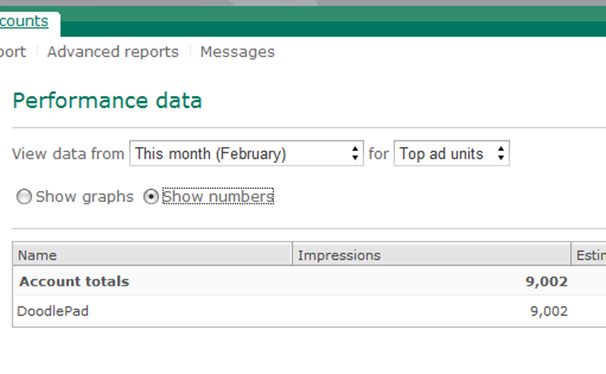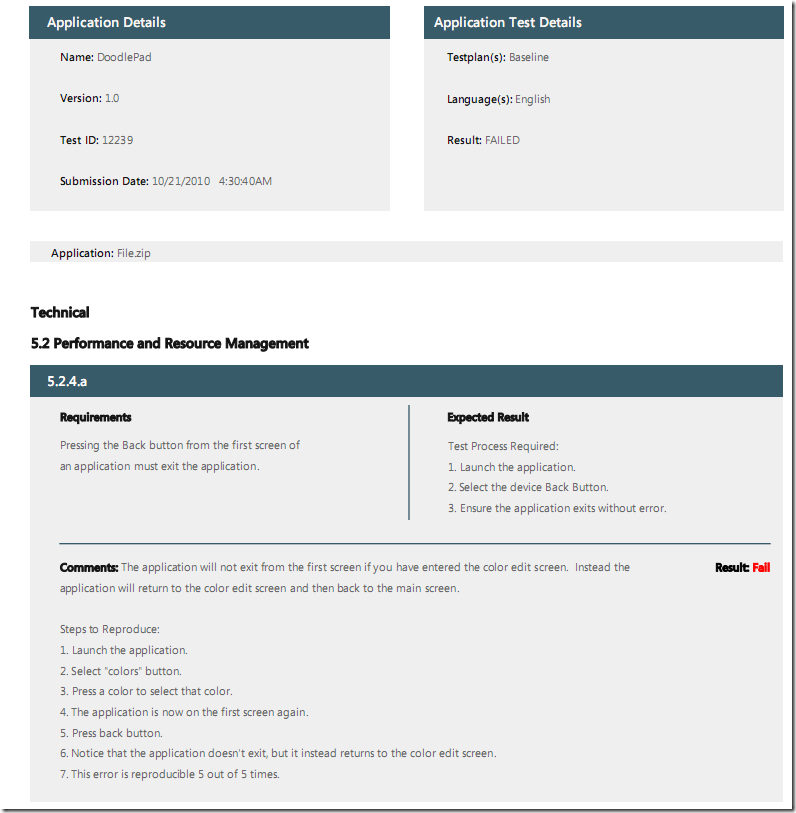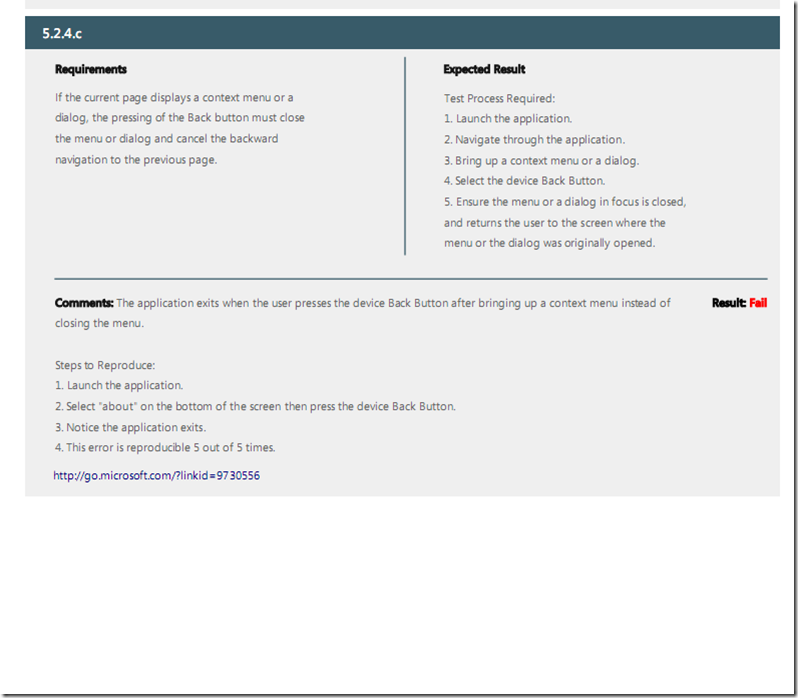What I learned about being a Windows Phone 7 Developer
Who is this guy?
First, let me start off by saying I work for Microsoft as a Developer Evangelist covering client technologies like Silverlight, Windows and Windows Phone. So it is a given I believe in the technology of Windows Phone 7 and am excited about its future. This doesn’t mean I am a robot who is forced to repeat the company line to you verbatim. I get paid because I am a developer first, going on fifteen years now (I’m a child of VB4 ) with only four of those spent as a Microsoft employee. I have been around long enough to have seen the promises of abandoned technologies as well as the fruits of successful breakthroughs. Those that have seen me present know I talk as much about how we can improve our products as much as where we are totally rocking right now.
I’m also a mobile gadget geek. I have always loved the concept of Mobile Computing it just seems that the hardware never seemed up to the task.
Yes that’s me in the shorts, you can take the boy out of the jersey shore but not the shore out of the boy! Apologies too to my woman coders out there ahead of time when I say “you guys” its my jersey upbringing again I mean everyone. The above picture was taken in 2002 and I’ll award a free t-shirt to anyone who can count the number of Dell Axim’s in that shot. I, like a lot of developers at the time, quickly tired of hearing the promise of Mobility’s future and the lack of any follow through in the hardware space. It wasn’t until 2007 when Apple came on the scene and changed what we thought about mobility that things change. That’s when I started getting excited again.
I tried out Objective C and X-Code I really did. I tried out Eclipse and the Android SDK. I don’t have my head in the sand and I also don’t live in Redmond. I live in Pennsylvania amongst a community of thousands of .NET Developers who will show up in the hundreds (500+) on a Saturday to talk shop. I see people using competitor devices, I’ve coded in the tools and I hope when I speak its from a place of experience and not blind marketing. I think you guys as developers can spot that in an instant and it is one of those things I love so much about our industry. Developers have a sense of honor of what's right and wrong. I think that’s why you see such passionate dialog online too. Do you know there are over a million and a half .NET Developers on the East Coast? If you look at Microsoft IT Pros there are another three million. That’s a lot of folks and that’s just on the Microsoft stack! I feel , like a lot of you do here, that the Valley sometimes forgets our side of the country and maybe New York will change that. Microsoft does gets that though and that’s why my team is here – all ten of us covering east coast developers.
I also want to point out while I will celebrate my platforms successes and strengths I will not openly bash competitors (what can I say he’s an old Microsoft DPE guy and we can’t help being passionate). So if you came here to find that you won’t. What I believe is that the market , including you developers, will be the ones who ultimately decide success. There are some great things on those other platforms and I have nothing but love for those developers. But, I was a .NET guy and after using tools like Expression Blend I wanted something that took advantage of that. I know a lot of you can relate and man did we have to wait a long time, eh? But that time is here and our time is now. Make it or break it Windows Phone 7 was going to be my entrance back into the Mobile space and that meant not just doing my Microsoft job of teaching developers about the platform but also bringing an app to market. It was time to put my money where my mouth is, get down to coding and Ship It! Having been out of the mobile development space for a while though I realized I needed to understand what was working for developers and what wasn’t. So who better to talk to than you guys?
Thinking about being a Mobile Developer? Go talk to Mobile developers.
The first time I got a glimpse of what was coming with Windows Phone 7 was at MIX10 last year. We had an internal briefing for field employees intended to cover all the mobile changes in the coming months. This eventually turned into the Windows Phone 7 Champs program and it was during the summer that I got my first developer device, an LG Pacific. Over the next six months I got to travel and talk to mobile developers across the East Coast US as well as lead the content and present at our national Windows Phone 7 Developer launches. Android , RIM and iOS all came up and I learned a lot. Topics such as free versus paid were pretty common as well as the developer tooling. I couldn’t help but feel a bit nostalgic it reminded me so much of the early dot-com days when I first took the leap to a professional developer from an IT Pro. Technology was changing fast, new platforms were being adopted at great speed. Developers were still developers back then and just like today they share solutions to the same problems, the same excitement, and the same wide eyed expectations of future rewards. Another feeling was in there air too - no more layoffs, outsourcing down trending, we were back baby and the sky was the limit!
What kind of advice did I get?
When I look back there was two things that really stuck with me and lighted a fire under my coding fingers.
- The first was don’t be afraid to take the leap! Everybody has a great mobile app idea but very few actually go out and do it. If you look at the number of downloads we have had for the Windows Phone 7 SDK (over a million), the number of registered developers (over 24,000) and the number of apps (about 8,000) you will start to see what I am talking about. If we do a little math we will see that out of all the downloads the number of registered accounts is less than 5% and only one developer in every three accounts has published an app. I can’t talk about what’s in the app queue for marketplace since we don’t publically share those numbers. But lets just say its very healthy and someone may already be in the queue with your app idea. Just like in life talk is cheap and actions speak louder than words. Just do it!
- The second lesson was know your market. Most Android developers I talked to said Ads were the way to go. iOS developers said go paid if you think you can reach the top of the charts otherwise go free. My approach for Windows Phone 7 was to start out paid (99 cents) and then depending on how I did on the charts I would release a free version at some point in the future (wound up being 2 months later). I will elaborate on this more when I talk about paid versus free but my advice for you is to try both.
- The third was keep it simple. Too often developers look at mobile apps like they do the web or desktop. Never forget that this is a very small device with a very small screen. It is also a personal device with very personal experiences. The phone follows you around and you move through these experiences together. If you have a bunch of ideas then make a bunch of apps don’t overload your customer. If your App invokes an emotional response, for good or bad, it is going to be a personal one. More so than a desktop or web app.
Common Questions
The idea behind this and upcoming blog posts is to share my own windows phone 7 development experiences and the stuff that worked and didn’t work for ME. Your experience could be quite different than mine. My hope is you came across this blog post and maybe you are trying to decide whether to develop for Windows Phone 7. You’ve read the training materials till your head hurt, you are into the promise of what Microsoft is trying to deliver and may even own a device already. You now long to hear some first hand accounts of what to expect and this is my story.
If by some chance you’ve come looking for Windows Phone 7 specific Training materials I won’t repeat all of that here. There is enough good content out there now for our RTM release. When we start to release updates to the operating system you can expect to get training style content from me. The good news is the training materials out there are absolutely stellar and in my opinion some of the best Microsoft has put forward. The WP7 Resource List I put together months ago is still applicable - https://bit.ly/WP7Resources . Windows Phone 7 has a very active community as well. New content is posted each day so much so we put together an ongoing Reddit List here: https://www.reddit.com/r/wp7dev. If you are looking for short 5 min burst videos then most popular ones by far are the MSDev "7-in-7" series. These are core topics for WP7 all done in 7 minutes and my personal favorites: https://www.msdev.com/Directory/SeriesDescription.aspx?CourseId=158.
Ok, with that out of the way lets get right down to the juicy stuff…
‘What do your download numbers look like for your app?”
I have released two versions of my DoodlePad application onto the marketplace. The idea behind the App was a quick sketchpad you could pull out wherever you are. For me that could be boredom during a meeting, taking a picture of a friend and doodling over their face, or giving it to my kids for a few minutes. Those principles is what shaped the design of the application and probably took the longest. I spent about 40 hours of design and usability testing and only 30 hours of actual coding. Granted the coding took less because I was already familiar with the tools and platform I would double it if you are just starting out. Quick and simple was very important for me too especially from a customer perspective. In and out with the ability to both share your application (when you save doodles they are Ad free) and customize (choose backgrounds, take a picture, create custom colors). If I had to add help documentation into the app than my design had already failed. Again – follow the principle of keeping your mobile apps simple and good at one thing.
To date both versions of DoodlePad have seen downloads in the thousands.
Above is the chart for the free version of DoodlePad and as you can see in less than 4 weeks it has already seen over 3,700+ downloads. Daily averages appear to be around 80-150 a day. The bump you see around January 11th is because I was at the top of the list for new applications. What is important to see here is discoverability will help get you downloads. Luckily everybody will get this bump the first time you are published to the marketplace. You will see similar bumps if you get featured but I will go into that more in a bit.
Keep in mind that these downloads are Global and you need to do absolutely nothing extra as a Windows Phone 7 developer to deploy globally.
As someone who has lived and worked in New Jersey and Pennsylvania all of my life it was so cool to see people from all over the world downloading, using, and contacting me about their experiences with DoodlePad. I can’t say enough about that even if your app doesn’t generate huge success the experience alone is something I think we should all do once. Some of these overseas sales are very strong too. Germany for instance is close behind the United States for DoodlePad. Hasselhoff background in the next version anyone? I kid guys – much love! In fact this probably says more about the creative talents of Europe versus some of the other countries . You guys just love to doodle.
“Have you gotten paid any money yet?”
Yes! Without being tacky and giving actual revenue numbers I can share that the conversion to Paid from Trial versions was better than I thought it would be around 28% . Ads in the free version are earning anywhere from $1 to $9 US a day with it averaging lower on that scale. Interestingly the Saturday before the Superbowl saw the highest daily eCPM and Sunday the second highest.
Keep in mind you will not see any money till you hit $200 revenue with paid apps or $50 in one month with Ad based apps.
“Should I go Trial, Free or Paid or some combination?”
Plan to create both versions of your application. Once you get a feel to how your app is selling you can chose where to focus. Free seems to be selling a lot more for ME than my Paid/Trail version. I imagine a lot of this depends on how discoverable you are though. Ask yourself are there already other apps that do similar things to what my app does? Are they at the top of my categories charts on the marketplace?
For DoodlePad there were about ten other apps that did a very similar thing (draw/doodle). I was also at a disadvantage being a Microsoft employee since employees are not allowed to have their applications featured in the Marketplace. We are also not allowed to be featured on any of the Microsoft Websites that promote Windows Phone 7 apps. This means all of the awareness I generated was through word of mouth whether that was one person recommending the app to another or a quick post to Facebook and Twitter. Some of the apps that were similar to mine were even featured on the Microsoft intranet – talk about competition!
Even with all of those disadvantages and no marketing my app has managed to be successful. According to the WP7 Marketplace Search App data today the Marketplace is currently ranking DoodlePad 336 out of 7,402 apps. That puts me roughly in the top 5% of apps but I am far from easily discoverable. It takes quite a while to find me in the marketplace if you scroll down through the list apps. If you go directly to Entertainment I am still a bunch of pages down although I am in excellent company right next to my buddy Dmitry’s TWiT app.
What does that mean? It means the user base is now large enough that there is room for multiples apps that do similar things (at least free apps) to all be successful. It also means you don’t necessarily need to be featured or heavily marketed to begin to make a profit.
“Are Microsoft PubCenter Ads any good?”
I certainly think so. I got over 26,000 impressions in the first three weeks using Microsoft Pubcenter and the provided Windows Phone 7 control. eCPM has been very good when I talk to other mobile developers but I also picked Ad categories that matched a drawing application (Art Schools, Entertainment, etc).
Another plus was all my Pubcenter questions were answered via email by the support staff within 30 minutes and billing certification was completed in a week (faster than marketplace!) Above are the number of Ad Impressions DoodlePad saw between January 11, 2011 and January 20, 2011. Looking at the numbers for February the impressions seem to be very similar to the previous month. So the people who have downloaded the application are in fact using it and hopefully enjoying it (as the reviews and emails I’ve gotten seem to day).
The reports for Ads can also be pulled down live so I know throughout the day what my impressions are. This is in stark contrast to the Marketplace Apphub Reports (which I’ll cover in a later post) that are sadly still a full week behind.
“Did you fail certification? How long does the process take?”
This is going to be a personal experience I imagine. I have talked to developers who had nothing but pleasurable experiences going through Certification and others who were left confused at times. For me the experience was very good and informative. The first time I submitted my application I failed certification and the report I got back was extremely detailed.
Not only did it list all of the reasons (instead of just the first one found) but it also pointed me to the exact item number in the certification guidelines as well as steps on how to reproduce the issue. Here is the complete report and what it looked like.
The report was very useful to me and after I went back in and fixed the issues my app passed certification successfully. Coincidently, Back Button and other Navigational issues are one of the top reasons apps fail certification so I was in good company. I will cover some tips and what I did differently as we move through this blog series.
Summary
I hope the data here speaks to the fact that the Windows Phone 7 Marketplace is thriving, growing and already capable of generating revenue for your apps. Having a successful app now means you will continue to see revenue grow as more devices are sold. I can’t speak for other developers but I am already seeing growth in revenue month to month about ~ 20%. I can’t think of another thing I’ve done in this life where I put two weeks into it and it continues to reward me everyday. Well other than having two little girls but they bring me a different type of success.
Of course any one of you guys could write a better application than mine tomorrow and push me off the charts. I welcome it! That’s what what mobile development is all about and it will only push me to be better or create something new. Like any other mobile dev will tell you too you’re not a real mobile guy till you sit there refreshing the app certification page all day long. Studies on OCD could have probably benefited from watching me during my firsts applications submission.
